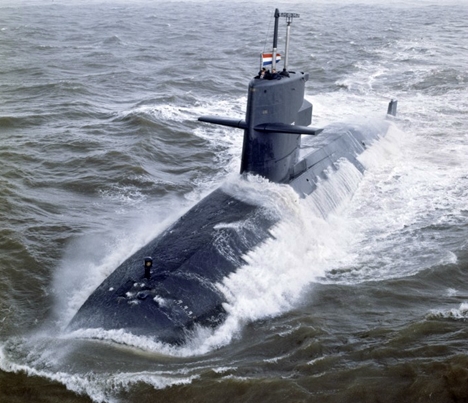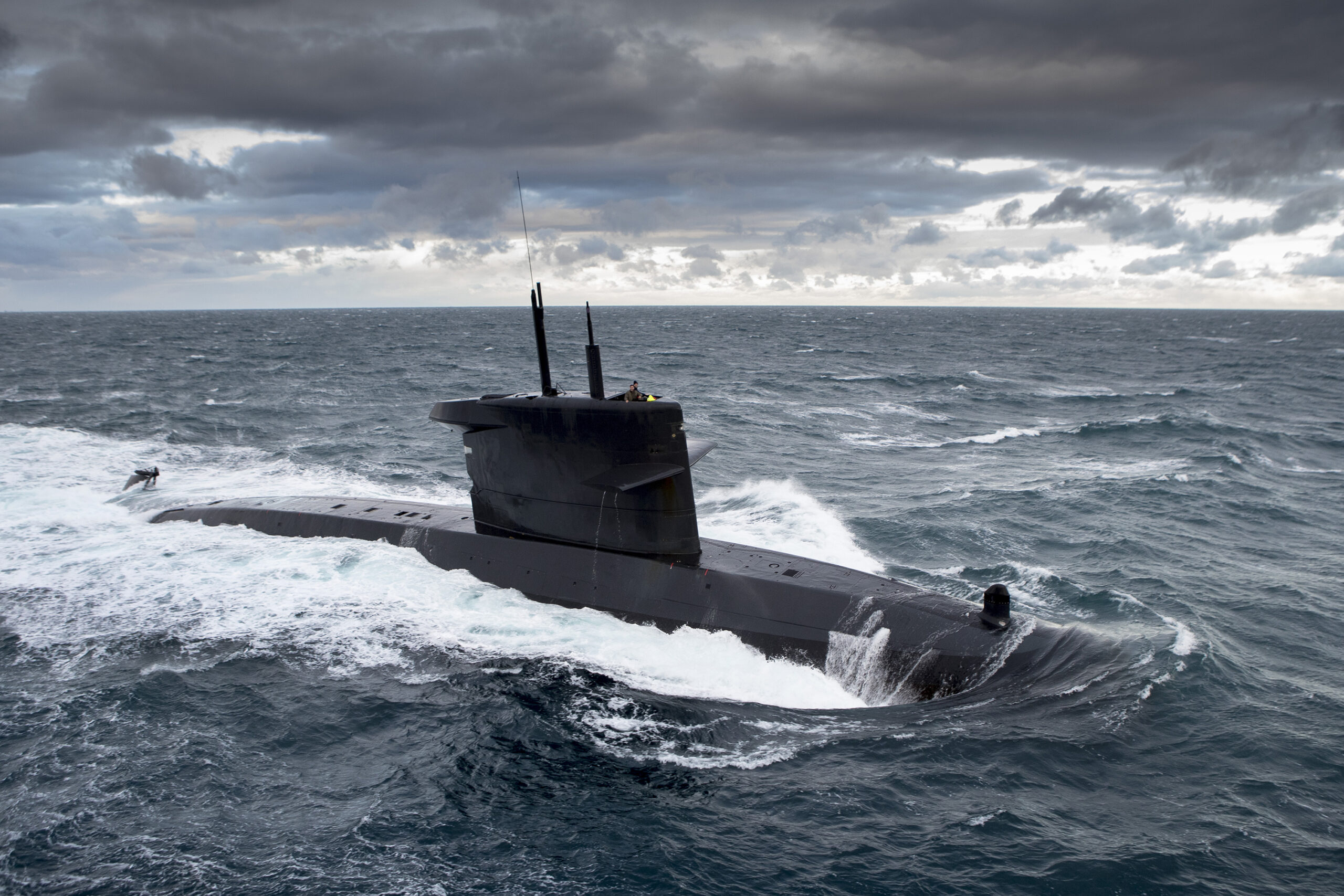Do conventional submarines need diesels in the future?
When you think of conventional submarines, you think of batteries and diesel engines. However, that might change completely. Naval architect Sven Los from Nevesbu presented a new concept: the electric submarine. Without diesel engines. A submarine revolution?

The Moray 1800 without diesel engines. In this submarine, they have installed as many lithium batteries as possible. (Image: Nevesbu)
Ever since the early days of modern submarines, some 120 years ago, conventional submarines have been sailing on batteries that can be recharged at any time with the help of onboard fuel generators. That concept has barely changed, despite all technological developments. Yes, thanks to the snorting mast, a submarine can also stay submerged during charging, and air-independent propulsion (AIP) has created a small revolution. Because of AIP, next to diesel generators and batteries, submarines can stay submerged even longer.
The next step might have much more impact. If the diesel engines are removed from the submarines and many more batteries are installed, Sven Los believes this will result in a less complicated design, less maintenance, a smaller crew, less chance of detection and lower costs (in acquisition and operation).
On board of a classic diesel-electric submarine, depending on its size, there are two to four diesel generators plus systems such as a snorting mast, tanks for fuel, an exhaust gas system and many pipelines to connect all these parts. This takes up space and requires maintenance both at sea and on shore. In addition, certain parts, such as valves, are sensitive. The diesel generators and the snorting mast also provide an increased risk of fire and leakage. This is why there is a lot of technical staff on a submarine.

Sven Los graduated from the TU Delft. Since then, he has been working as a naval architect. (Photo: Nevesbu)
Graduation project
Jaime Karremann from Naviesworldwide.com/ Marineschepen.nl spoke to Sven Los at the IV-Group’s office in Papendrecht (the Netherlands), an organisation of which the maritime engineering firm Nevesbu has been a part since 2004. Nevesbu was founded in 1934 and, together with the Dutch navy, took care of the designs of various cruisers, destroyers, frigates and submarines. Nevesbu was involved in the design of all Dutch submarines since 1945 andthe Hai Lung class submarines of Taiwan. Nevesbu also contributed to various foreign designs and to the upkeep programme of the Walrus-class. As a subsidiary of the former Dutch shipyard RDM, it also designed the export submarine Moray.
However, the agency is also constantly researching opportunities to innovate. When Sven Los started his graduation project at Nevesbu in 2017, he was given the assignment to conduct research into fully electric submarines.
Los: “A graduate before me had made a very nice model of a submarine’s propulsion system and he compared different configurations, such as diesel-electric with lead-acid batteries and diesel-electric with lithium-ion batteries. Those resulted in great improvements which made people at Nevesbu think about 100% electric submarines. ”
Los focused on today’s technology. The current submarines still use lead-acid batteries, but smartphones, laptops and electric cars use lithium batteries. Los: “Lithium batteries have undergone major developments in recent years. They have an enormous energy density, which makes electric sailing a realistic possibility.”
Soon, it turned out that the profits could be huge, but to figure out the exact impact, Los simulated the concept in a propulsion model to answer the following question: “What could you do with an electric submarine and could it be interesting for certain navies?”

The Moray was a concept submarine that was designed by Nevesbu in the 1980s on the basis of the Walrus and Zwaardvis class and had to be sold by RDM. Until the beginning of the year 2000, RDM unsuccessfully tried to offer the different versions (1100, 1400 and 1800) to Indonesia, Thailand and Egypt, among others. This advertisement dates from 2001. (Image: RDM)
Interest from abroad
Although the idea of an electric submarine seems to be fairly simple, it is unique. In any case, nothing has ever been published about it. In June 2018, Los presented his research results during the submarine symposium UDT in Glasgow, where there was a lot of interest in his project. Los: “Everyone was enthusiastic, especially because it is a very different way of thinking. People often only think of two kinds of propulsion: diesel-electric or nuclear, and my research was an eye-opener. Many people saw that fully electric submarines could have many advantages.”
However, the electric submarine is still something for the future. “The battery technology is fairly new and the capacity is not sufficient just yet. But, you have to work on it now in order to be able to implement it in twenty years. If you look at how much the capacity of batteries has improved over the past ten years, then this must be a realistic design.”
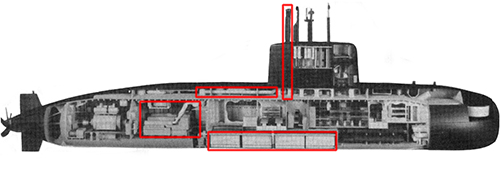 The Moray 1800 as it was designed and published by the Dutch newspaper De Telegraaf (22 April 1989). In red, you can see the major parts that are removed or changed. The replacement of the diesel engines (left) with batteries would be the biggest advantage. The existing lead-acid batteries (at the bottom) are replaced by lithium batteries. (Source: Delpher / De Telegraaf, adaptation: Jaime Karremann / Marineschepen.nl)
The Moray 1800 as it was designed and published by the Dutch newspaper De Telegraaf (22 April 1989). In red, you can see the major parts that are removed or changed. The replacement of the diesel engines (left) with batteries would be the biggest advantage. The existing lead-acid batteries (at the bottom) are replaced by lithium batteries. (Source: Delpher / De Telegraaf, adaptation: Jaime Karremann / Marineschepen.nl)
E-Moray 1800
Los’s design is based on the Moray. This submarine was developed by Nevesbu in the 1980s to be sold by RDM.
Los changed the Moray 1800 (of about 1800 tons, comparable to the French Scorpène, the German Type 212A and the Swedish A26) into a fully electric submarine. “Because Nevesbu designed the Moray, there’s a lot of information about it.I’ve changed the design so I can put in as many batteries as possible . I did not make the submarine smaller, I just used the space in a different way. The dimensions of the submarine have stayed the same, so I could make a comparison.”
The result is an electric Moray-1800 without engine room, snorting mast, fuel tanks, fuel pipes and all kinds of other equipment. The accommodation has been moved backwards and a lot of batteries have been added.

The electric concept submarine can go round the Baltic Sea under water, which is a distance of about 3500 km. A diesel-electric version would have to snort after about 550 km. (Source: Nevesbu)
Submerged for one month
The result is amazing. Los: “A diesel-electric submarine can stay submerged for a few days and then cover 300 nautical miles. The electric variant can stay under water for 25 to 30 days and sail 2,500 nautical miles underwater.”
That means the electric submarine can sail around the Baltic Sea while submerged.
The electric version loses against a diesel-electric variant as soon as it starts snorting or surfaces and starts its diesel engines. “From then on, a diesel-electric boat has a range four to five times as large as an electric version.”
However, the question is whether it is necessary for a lot of navies to have a submarine that can sail long distances. “You have to ask yourself in a very early stage, what you want to do with such a submarine. The Swedish SSK’s, for example, mainly sail submerged in the Baltic Sea and I have heard that those submarines are only away for short periods of time; days or maybe two weeks.”
“For such profiles, a design like this is very interesting, because the Swedish submarines almost immediately enter their patrol area. Dutch submarines first have to transit long distances.” For example, in the past, Dutch submarines have been operating mainly in the Norwegian Sea, Mediterranean Sea and even in the Indian Ocean and Persian Gulf. Like their Canadian and Australian counterparts, they are weeks or months away on a deployment.

On the high seas this will be a thing of the past. (Photo: Jaime Karremann / Marineschepen.nl)
Just stay submerged
Conventional submarines quite often sail surfaced during long transits. “Of course, you can still do that with an electric submarine, but it will not have any benefits. The drag is generally much higher. So, an electric submarine will submerge as soon as possible and will surface only in emergency situations or for a barbecue. ”
Long periods of submerged sailing also have consequences for the air quality, which rapidly deteriorates. “You have to look at submarines with AIP or nuclear boats that have been under water for some time. The biggest difference with nuclear submarines, however, is that thanks to the nuclear powerplant you have a lot of energy at your disposal, so you can get oxygen from sea water. For electric submarines, I would consider a tank of liquid oxygen.”

A snorting submarine runs the risk of discovery by heat radiation, noise (from the diesel engines) or because one of the mastsspotted with the naked eye or a radar. (Photo: NIMH)
Stealth submarine
Diesel-electric submarines regularly have to recharge their batteries. The least noticeable option to do that is sailing at periscope depth, putting the snorting mast out of the water and starting the diesel engines. But, a snorting submarine can be detected in several ways: the diesel engines make a lot of noise, the submarine sails just below the surface of the water and can be seen in clear water with the naked eye or with magnetic sensors, the diesel engines produce a lot of heat, and the masts can be seen by radar.
A submarine that does not have to snort has a huge advantage, as we have seen with nuclear submarines. But there is more, Los discovered: “To start with, an electric submarine doesn’t have the extreme signatures of snorting, and in addition it does not have any fuel on board, so you need fewer valves and pumps.” These valves and pumps produce noise when fuel from a tank is used and the weight of the boat has to be corrected. The electric submarine is therefore also quieter when submerged than a diesel-electric submarine.

As the book In deepest secrecy shows, during a patrol, diesel-electric submarines leave their patrol area before they start snorting. To go to that snorting position, they first have to transit for a while and when they are not in their patrol area they might miss crucial intelligence. An electric submarine can stay in its patrol area for much longer.
Less work, less maintenance, less crew, less recruitment, less costs
Half of the crew of diesel-electric submarines are technicians, and the majority is involved with the propulsion. Removing the diesel engines results in an enormous reduction in staff. Originally, it was planned that the Moray 1800 would need 34 crew members . Sven Los: “The number of people needed for maintaining and controlling technical systems will be reduced. There is no need for surveillance in the engine room, there is no snorting mast that might take in water accidentally. With less systems, there is less chance things break down. Especially if you also replace the hydraulic systems with electrics. That means a huge reduction in hydraulic systems and pipelines. That way, you can leave out a lot of mechanical systems. Less energy is needed and there is less work to be done. Maintenance for the lithium batteries is not needed, you might even not do any maintenance. The only thing that still requires maintenance are small pumps.”
“I expect that it is possible to reduce the size of the crew, depending on the requirements and automation on board, to 18 to 20 people.” This obviously saves costs (salary, training, etc.) and the recruitment department doesn’t have exert itself to recruit technicians.
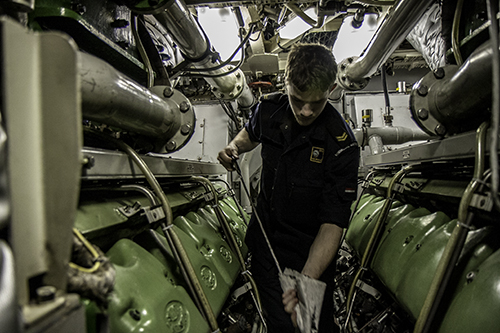
Diesel engines take up a lot of space, require staff and maintenance. (Photo: Jaime Karremann / Marineschepen.nl)
Less crew; risk in case of fire?
Continuously reducing the number of crew members is obviously interesting to limit costs, but is not it more dangerous in the event of a fire? Sven Los does not think so. “I often hear that crew reduction is a risk when there is a fire on a submarine, but a huge risk is taken away by removing the diesel generator set. Most of the fires start there: it is warm, there are rotating parts, oil, exhaust fumes. The battery compartment is much more manageable and these are also compartments you can shut off. Plus, in case of a fire in the battery compartment, I would not send people in to extinguish it. ”
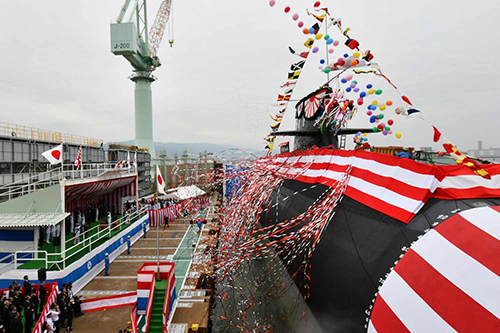
Japan believes in lithium batteries for submarines. JS Oryu was launched in early October 2018. For this submarine Japan has exchanged the Stirling engine (AIP) of Saab Kockums for lithium batteries. The sub still has diesel engines. (Photo: Japanese navy)
Safety of lithium batteries
During his research, Los first investigated the available battery technologies and looked at which would be best applicable for submarines. Lithium batteries turned out to be the best.
The advantages of lithium batteries compared to those of lead-acid batteries are, for example, that lithium batteries are much smaller. A submarine with lithium batteries can also sail longer.
Lithium batteries, however, are known for their risk of fire. There are lots of stories about exploding smartphone batteries or burning electric cars. “That’s a risk,” Los acknowledges, “but it also applies to lead-acid batteries, which produce hydrogen gas during loading or unloading. That means there is a risk of an explosion, which is not the case with lithium batteries. Those batteries might catch fire. The downside is that these batteries are small and installed in packs, so if one battery catches fire, there might be a chain reaction. ”
However, many of the incidents involving lithium batteries involve cheap batteries of poor design. Large battery manufacturers such as Panasonic and Kokam are working on special submarine batteries and pay a lot of attention to safety mechanisms for these batteries. Los: “These safety measures are already built in at cellular level. They are also developing cells that are resistant to external heat sources and prevent a chain reaction. Also, other cells can be automatically switched off and cooled as soon as the battery becomes overloaded.”
Hence, the effect of fire in one battery becomes minimal, because there are a lot of cells, explains Los. There is no need for a separate backup according to him, because “they are all backups”. If batteries are damaged by fire or something else, there is enough spare capacity.
And shock? The shock requirements on submarines are strict. That should not be a problem according to Los. “If you drop your phone, your screen might be shattered, but the battery will still work. Besides, some manufacturers say they meet the shock standards for submarines of certain navies.”
Charging at sea
An electric submarine cannot charge its batteries itself. Recharging has to be done in port, but that can be done in quite a short time, says Los. The batteries of his concept submarine can be charged in 16 hours, at its fastest.
The submarine does not even have to go to its home port or a naval base. Recharging is possible almost everywhere. “You do need a certain voltage and the connection must be suitable, but it is relatively simple. All major ports have shore power connection and the submarine has to be designed in such a way that the batteries can be recharged in a civilian port. That might take a bit longer, but it does not directly affect the readiness of the submarine. ”
In the researcher’s view, it is also possible to order a diesel generator and recharge the batteries that way.
That already provides more flexibility, but Nevesbu has continued to think outside the box for solutions . “We have also talked about charging via a support ship. The submarine can sail next to a replenishment ship that uses its diesel engines to transfer energy. I don’t know if any navy could be interested, but it certainly is possible. ” Many countries have submarine support vessels, so the concept of charging at sea might be relatively easy to apply for them.
Nevesbu’s search for more solutions did not end with charging at sea. “You can come up with all kinds of futuristic ideas, such as submerged charging stations or a floating wind farm with tapping points for submarines. But that is more 007-style,” Los admits. “Technically it could be possible, but whether it is realistic, is something else.”
For whom?
Back to reality. The technique is not ready yet to be appliedto submarines used for operations thousands of nautical miles from home. InLos’s view, the electric submarines are especially suitable for countries that now want to operate close to home with smaller submarines. Countries such as Germany, Sweden, but also Greece, Singapore and Indonesia, for example.
There is, however, another interesting market: countries that do want submarines, but find them too expensive and / or too complex. They can not only purchase these submarines, but also design and build them themselves.
Although the concept is about the propulsion, electric submarines are easier to design and much cheaper to build. “The number of pipes in a submarine is huge. An electric submarine has far fewer systems to integrate; there are hardly any tanks left, much fewer pipelines and pressure hull penetrations. Pressure hull penetrations add to the complexity during the building phase, because they weaken the construction. The snorting mast and the system for exhaust gases are quite complex as well, and you do not need them anymore. If the number of systems reduces, you will have fewer interfacesand thereforeless chance of things going wrong.Also, lithium batteries do not need cooling and do not need to be designed and built, you just need more cables.”
“So, the use of electric submarines is easy, less maintenance is needed and there are fewer things that can break down at sea, especially if you compare themto boats that have the same submerged endurance, for example AIP submarines. An integrated AIP system is only suited for specialised technicians and there aren’t a lot of them. Especially countries that are new to submarines run into problems due to insufficient knowledge and experience.”
Sven Los expects electric submarines to be cheaper, because they need less maintenance. As a result, they will also be available more often. “Pipelines, the snorting mast, the exhaust gas system and auxiliary systems will take the most time during maintenance. I’m not an expert on submarine maintenance, but someone at Nevesbu, who is familiar with the Walrus class, said that maintenance costs would be reduced by 50%.”
Might these types of submarines in the future also be interesting for countries that operate thousands of miles from their home port with conventional submarines? Like Canada, the Netherlands and Australia? Los: “It depends on the development of battery capacity. The past decade, battery capacity has improved by 60%. If you add another 60% in the next decade, a lot of possibilities will open up. But still, a lot has to happen before the energy density of batteries comes even near the energy density of diesel. If they want a conventional submarine to cross the ocean, I do not think it will be a battery-only submarine. I expect in that case AIP is needed. ”
That is why Nevesbu is currently researching a concept of batteries and AIP.
Will electric submarines cause a revolution within the submarine world? It is likely, but as usual, it does not only depend on technological development, but also on the courage of admirals to move in that direction.
This article was published on Marineschepen.nl in Dutch.

